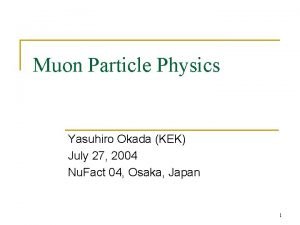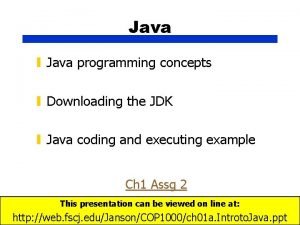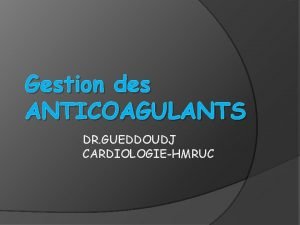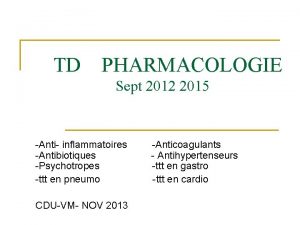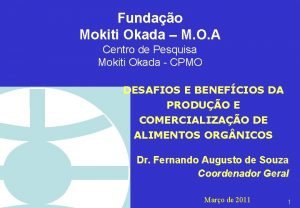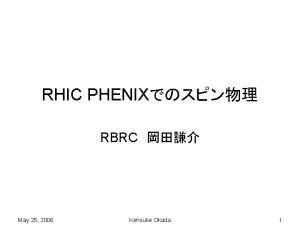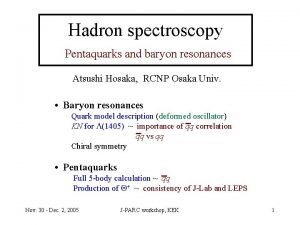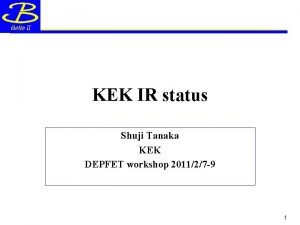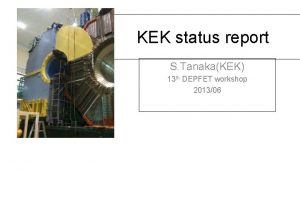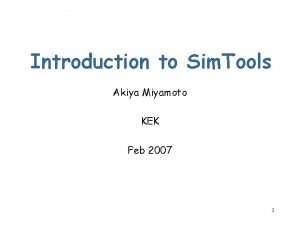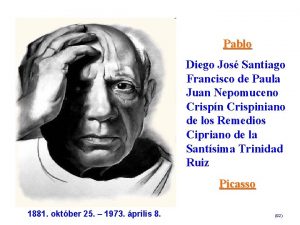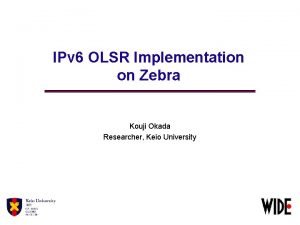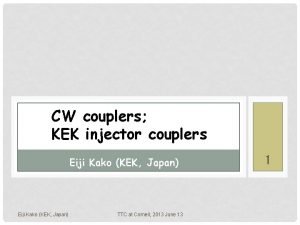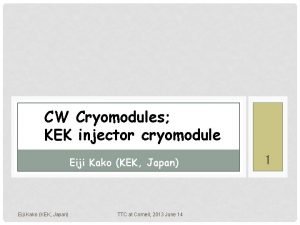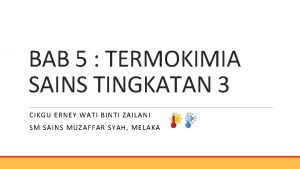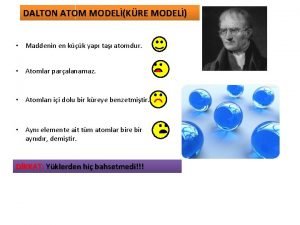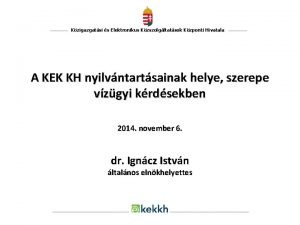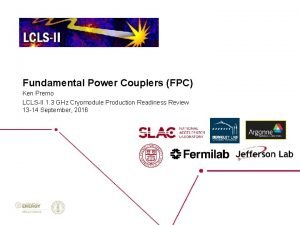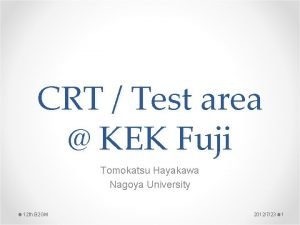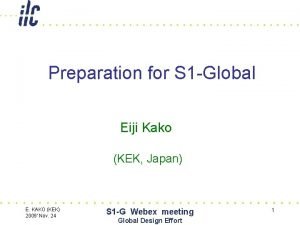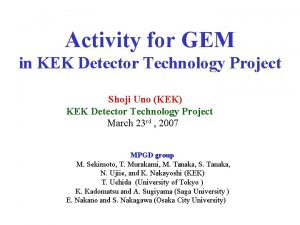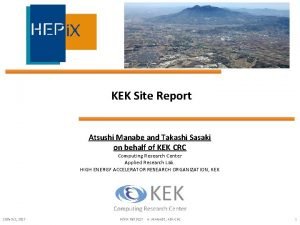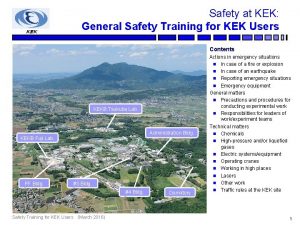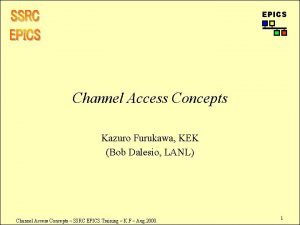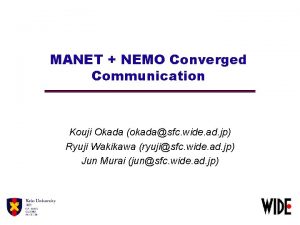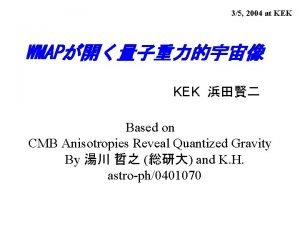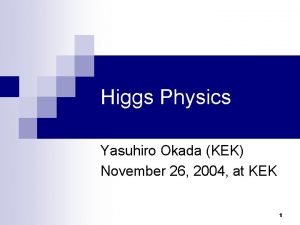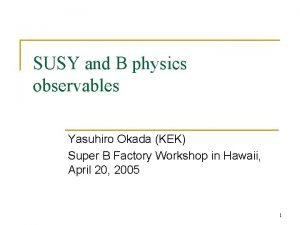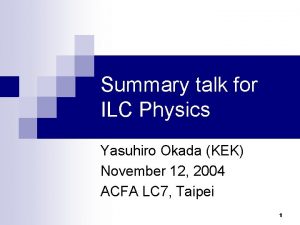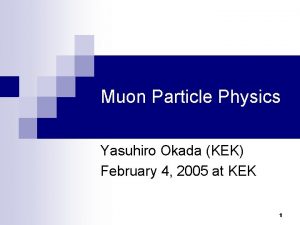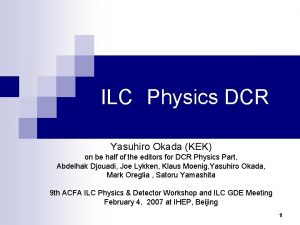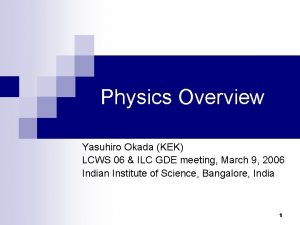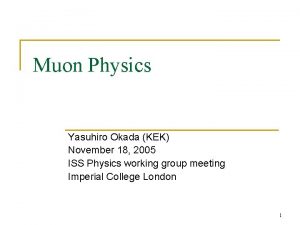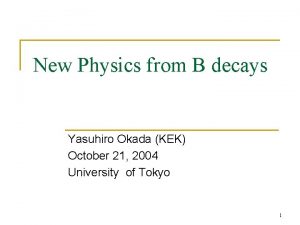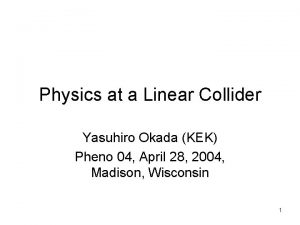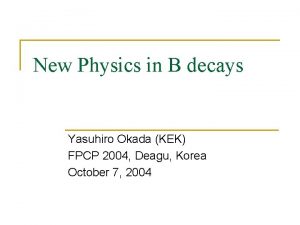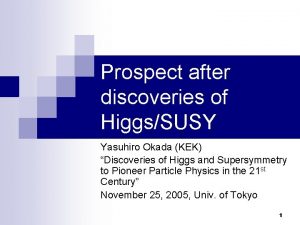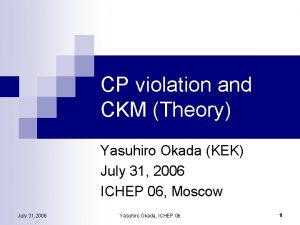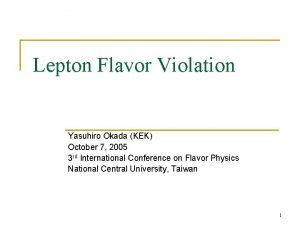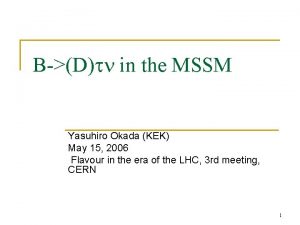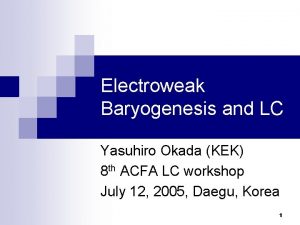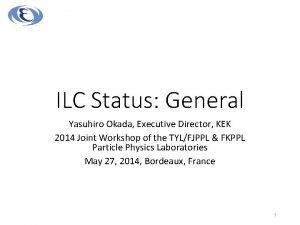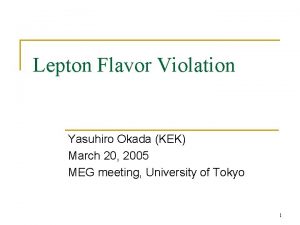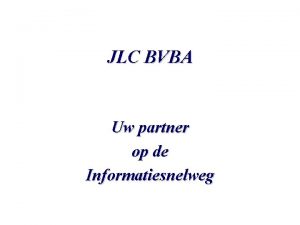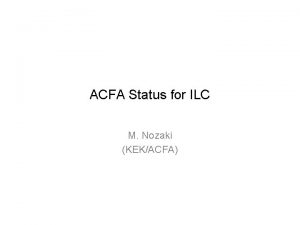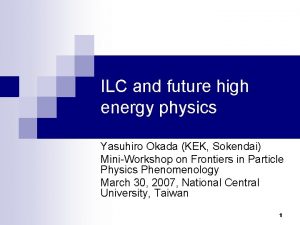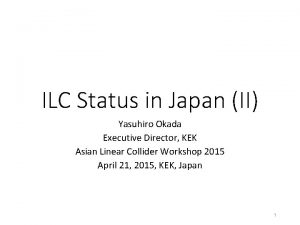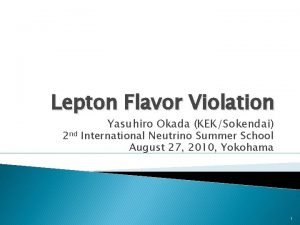JLC Physics Yasuhiro Okada KEK ACFA LC Symposium




























- Slides: 28

JLC Physics Yasuhiro Okada (KEK) ACFA LC Symposium February 12, 2003, Tsukuba, Japan February 12, 2003 ACFA LC Symposium 1

Fundamental questions in elementary particle physics What are the elementary constituents of matter? n What are forces acting between them? n How did the Universe begin and evolve? n February 12, 2003 ACFA LC Symposium 2

Our current understanding = The Standard Model of elementary particle physics quark lepton Matter : u c t Forces: February 12, 2003 d s b e m t ne nm nt gauge force ACFA LC Symposium 3

Developments of the Standard Model (SM) lepton quark Higgs mechanism gauge principle (Mass generation) 1970 “ Proposal of the Standard Model “ charm (SPEAR, AGS) 1980 bottom (FNAL) 1990 top 2000 photon e, m, n u, d, s t (SPEAR) gluon (PETRA) ( ) gluon-coupling (TRISTAN) gauge-interaction (SLC, LEP) (TEVATRON) KM mechanism for CP violation No experimental confirmation (KEKB, PEP-II) February 12, 2003 W, Z bosons ACFA LC Symposium 4

100 Ge. V Electroweak phase transition in Strong • Neutrino mass Super. Kamokande, Cl, Ga, exp. , K 2 K, SNO, Kam. LAND, … • Cosmology Time Gravity Supersymmetric grand unified theory, Superstring. Temp. t. • Unification Energy EM int. Weak int. Quest for physics beyond the SM See-saw neutrino Dark matter, Baryogenesis, Inflation, … Inflation SUSY GUT Need a higher energy than 100 Ge. V. February 12, 2003 Superstring Planck energy ACFA LC Symposium 5

Two types of accelerators: Electron-positron collider & Hadron machine Discovery of new particles J/y (charm), t, gluon Establishment of new mechanisms/principles Gauge principle CP violation Future machine February 12, 2003 JLC ACFA LC Symposium J/y (charm), b, W, Z, t LHC (2007 - ) 6

Worldwide consensus on construction of an electron-positron linear collider (LC) n n A worldwide consensus in the high energy physics community has been reached to construct an electronpositron LC which can operate concurrently with CERN LHC. Physics and experiments for LC with the center-of-mass energy of up to 500 Ge. V have been examined. JLC-I (1992) ACFA LC report (2001) TESLA TDR (2001) LC physics resource book for Snowmass 2001 February 12, 2003 ACFA LC Symposium 7

Goals of JLC physics 1. 2. 3. 4. Higgs physics ( Electroweak symmetry breaking and mass-generation) Direct signals for new physics (SUSY, extra-dimensions, …) Precision study on top and gauge bosons “Unexpected” new signals February 12, 2003 ACFA LC Symposium 8

Higgs physics Higgs Field • Fills everywhere in the Universe. • Breaks the electroweak symmetry. • Provides masses to quarks, leptons and gauge bosons. • A new particle is predicted. Studio R “Higgs boson” February 12, 2003 ACFA LC Symposium 9

Higgs boson search • The Higgs boson: Not yet found experimentally. 114 Ge. V < Mh < 193 Ge. V (95%CL) for the SM Higgs boson. • The Higgs hunting will be continued at TEVATRON and LHC. TEVATRON Higgs search February 12, 2003 LHC Higgs search ACFA LC Symposium 10

JLC = A Higgs factory Higgs boson signal Over 100, 000 Higgs bosons can be produced at JLC. Luminosity = 500 /fb, Ecm=300 Ge. V February 12, 2003 ACFA LC Symposium 11

Higgs coupling measurements Top Yukawa coupling Higgs boson branching ratios Coupling-mass relation The Higgs vacuum-expectation-value (Ecm >500 Ge. V) t Particle mass Higgs coupling constant b Mass-generation mechanism February 12, 2003 c ACFA LC Symposium 12

Higgs potential = Origin of EW symmetry breaking The first access to the Higgs potential through double Higgs-boson production. Need a higher energy for a precise measurement of the self-coupling constant. February 12, 2003 ACFA LC Symposium ACFA Higgs working group 13

More than one Higgs boson? ACFA Higgs working group Direct and indirect searches for heavy Higgs bosons at JLC. February 12, 2003 ACFA LC Symposium 14

Photon-photon collider Laser e- n n beam g g a few mm JLC can have an additional interaction point with photon collisions. The heavy Higgs boson can be produced up to 400 Ge. V for 500 Ge. V LC. February 12, 2003 ACFA LC Symposium g H/A g 15

Supersymmetry (SUSY) SUSY = Extension of the Einstein’s relativity (Extension of space-time concept. ) SUSY-partner particles Ordinary particle Super-particle quark squark lepton slepton gluino W, Z, g, H neutralino, chargino February 12, 2003 Studio R ACFA LC Symposium 16

SUSY particle search Smuon production and decay Dark matter candidate? February 12, 2003 Smuon and neutralino masses are determined to 1% or better. ACFA LC Symposium 17

Proving a new principle Test of a SUSY relation Test of the gaugino GUT relation Selectron production From selectron and chargino productions February 12, 2003 ACFA LC Symposium 18

LHC: Squark and gluino production and cascade decay JLC: Slepton, neutlarino, and chargino pair-production SUSY particle masses Determining SUSY breaking mechanism Combined analysis Energy scale SUSY breaking scenario February 12, 2003 G. A. Blair, W. Porod, and P. M. Zerwas ACFA LC Symposium 19

Large extra-dimensions Inspired by superstring theory, a scenario with large extradimension is proposed. graviton quark, lepton, gauge boson Studio R Quarks, leptons, and gauge bosons live in a 3 -dimensional wall. Gravity can propagate in 3+n dimensional space. February 12, 2003 ACFA LC Symposium 20

Search for extra-space at JLC K. Odagiri Graviton emission to extra-space # of extra-dimensional space The size and number of the extra-space may be determined at JLC. February 12, 2003 ACFA LC Symposium 21

Precision study on Top and W boson Top: The heaviest particle discovered so far. Top quark threshold scan Top production threshold scan Precise determination of mass and width Anomalous coupling measurements of top and W boson production. Physics beyond the SM February 12, 2003 ACFA LC Symposium 22

Detector of JLC The state-of-the-art detector • Very precise determination of momentum and energy of out-going particles • Heavy quark flavor tagging. • Identifying “invisible” particles. • Good timing resolution. Much cleaner environment compared to the LHC experiment. February 12, 2003 ACFA LC Symposium 23

Detector R&D for JLC Jet chamber test module Vertex detector test module 12 ton test module of the calorimeter Present Framework; ACFA working group. (Work by 15 institutes of Japan, Korea and the Philippines) Collaboration with Europe is developing (UK, Germany, Russia) Collaboration with North America, under discussion. February 12, 2003 ACFA LC Symposium 24

Summary of physics goals 1. Higgs physics Determination of Higgs couplings Origin of masses. Higgs potential Dynamics of the electroweak symmetry breaking. 2. Direct signals for new physics Discovery of SUSY or extra-dimensions concept. 3. Change of the space-time Precision study on top and gauge bosons Measurements of basic parameters of physics. 4. “Unexpected” new signals Advantage of an energy-frontier electron-positron collider. February 12, 2003 ACFA LC Symposium 25

Concurrent operation of JLC and LHC Establishing new principles Particle discovery Higgs physics TEVATRON LHC Higgs boson JLC Spin/parity Higgs self-coupling Coupling measurements Squark/gluino cascade decays TEVATRON Slepton/chargino/ neutralino February 12, 2003 mass-generation mechanism Supersymmetry SUSY breaking mechanism LHC JLC spin/coupling measurements ACFA LC Symposium Proof of SUSY 26

Physics research covered by JLC 1 st stage: Ecm =210 -500 Ge. V, Luminosity = ~ 200/fb x several years. 2 nd stage: Ecm = 1 Te. V or more. February 12, 2003 ACFA LC Symposium 27

Conclusions Goals of research at JLC are to open a new era of elementary particle physics through critical discoveries which lead to new fundamental principles of Nature. (Origin of mass, new concept on space-time structure, vacuum structure of the Universe, etc. ) n Rich physics programs are expected for the first stage of the JLC experiment with the center-ofmass energy of up to 500 Ge. V. n Energy upgrade to 1 Te. V or more is important. n February 12, 2003 ACFA LC Symposium 28
 Yasuhiro okada
Yasuhiro okada Java se1 8
Java se1 8 Finn zászló színei
Finn zászló színei Héparine non fractionnée
Héparine non fractionnée Trinoderm
Trinoderm Artstico
Artstico Centro de pesquisa mokiti okada
Centro de pesquisa mokiti okada May 25 2006
May 25 2006 Kek
Kek Kek
Kek Kek kds
Kek kds Kek 13
Kek 13 Kek tools
Kek tools Paula juan
Paula juan Kek manet
Kek manet Kako kek
Kako kek Kako kek
Kako kek Setiap tindak balas kimia melibatkan tindak balas perubahan
Setiap tindak balas kimia melibatkan tindak balas perubahan üzümlü kek atom modeli
üzümlü kek atom modeli Kek kh
Kek kh Premo kek
Premo kek Futaba kek
Futaba kek Kako kek
Kako kek Kek gem
Kek gem Kek
Kek Kek n
Kek n Bob kek
Bob kek Kek. manet
Kek. manet Kek based
Kek based
